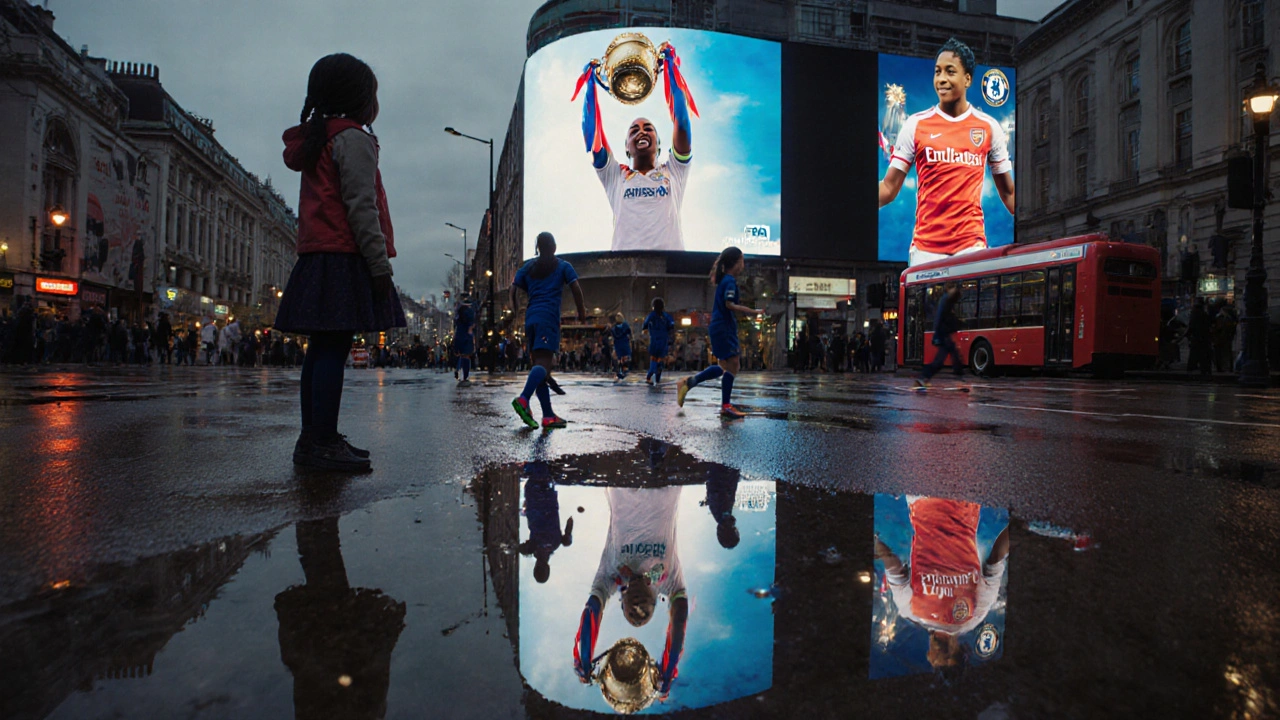
On a cold Tuesday night in November 2025, over 12,000 fans packed the Emirates Stadium, not for the men’s team, but for Arsenal Women. The crowd roared as Khadija Shaw scored her 18th goal of the season - a strike that put Arsenal top of the FA Women’s Super League. Just two miles away, at Stamford Bridge, Chelsea Women were preparing for their next match against Manchester City. These two clubs don’t just play football - they’ve reshaped what women’s sport looks like in London.
How Arsenal Women Became a Powerhouse
Arsenal Women aren’t just a team. They’re a legacy. Founded in 1987, they won the first-ever Women’s FA Cup in 1970 - yes, even before the men’s Premier League existed. By the early 2000s, they were dominating England, winning 12 league titles between 1992 and 2010. Their run of seven straight league wins from 2005 to 2011 still stands as a record in women’s football.
What sets them apart isn’t just trophies. It’s structure. Arsenal Women operate with a full-time professional setup: dedicated training ground at London Colney, sports science staff, nutritionists, and psychological support. Their academy feeds players into the first team from age 12. In 2025, 60% of their senior squad came through their youth system - a rarity in women’s football.
They’ve also attracted global talent. Sam Kerr joined in 2020 and became the club’s all-time top scorer. Leah Williamson, captain since 2022, has led them through injuries and transitions. The team plays an attacking style - high press, quick transitions - and they’ve scored more goals than any other WSL team since 2023.
Chelsea Women: From Underdogs to Champions
Chelsea Women didn’t start as giants. They were formed in 1992 as a semi-pro side, playing in local parks. But everything changed in 2012 when the club’s ownership poured money into women’s football. They hired Emma Hayes - a former player turned coach with a no-nonsense approach - and turned them into a machine.
Under Hayes, Chelsea won their first league title in 2015. Since then, they’ve claimed six WSL titles, four FA Cups, and the 2021 UEFA Women’s Champions League. Their 2023-24 season was historic: 23 wins, 1 draw, 0 losses. They didn’t just win - they crushed opponents. They scored 87 goals and conceded just 11.
Chelsea’s strength? Depth. They have 12 international players in their starting XI - from England’s Beth Mead to Spain’s Alexia Putellas. Their training facility at Cobham is one of the best in Europe, with hydrotherapy pools, GPS tracking, and AI-driven performance analytics. Unlike some clubs, they don’t just sign stars - they build them. Their academy has produced 14 players who’ve gone on to play for England’s senior team.
The Rivalry: More Than Just a Match
Arsenal vs. Chelsea isn’t just another game. It’s the biggest fixture in women’s football in England. Since 2010, they’ve faced each other 38 times in all competitions. Chelsea leads the head-to-head with 19 wins, Arsenal has 14, and five ended in draws. But it’s not about numbers - it’s about identity.
Arsenal fans see themselves as the traditionalists. They value history, youth development, and playing beautiful football. Chelsea fans see their team as the modern revolution - ruthless, data-driven, and built to win at all costs. The rivalry spilled into the stands in 2024, when Chelsea fans brought a giant banner to the Emirates reading: “History doesn’t win trophies. Execution does.” Arsenal responded the next season by signing three academy graduates to their first team - a statement of pride.
These matches now regularly sell out. The 2025 FA Cup final between them drew 52,000 fans to Wembley - the largest crowd ever for a women’s domestic cup final in the UK. Ticket demand is so high that both clubs now use a lottery system for away fans.

What Makes London Different?
London is the only city in the UK with two top-tier women’s football clubs that regularly compete for European spots. No other city - not Manchester, not Liverpool - has this depth. The capital has 11 WSL clubs in total, but only Arsenal and Chelsea have the infrastructure, funding, and global brand to compete at the highest level.
Why? It’s simple: money and media. Both clubs are owned by billionaires - Arsenal by the Kroenke family, Chelsea by Todd Boehly’s consortium. They get broadcast deals with Sky Sports and the BBC. Their matches are shown live on prime-time TV. Their players appear on billboards in Piccadilly and on Tube ads.
But it’s not just about cash. London’s size gives them access to talent. The city has over 200 girls’ football clubs. Every year, scouts from both teams visit schools in Croydon, Lewisham, and Haringey. In 2024, 37% of the England women’s squad came from London-based academies - and half of them were from Arsenal or Chelsea’s systems.
What’s Next for Both Teams?
Both clubs are investing in the future. Arsenal announced a £15 million upgrade to their training complex in 2025, including a 5,000-seat stadium for their reserve team. Chelsea is building a new youth academy in West London, set to open in 2026. They’re also launching a community outreach program targeting girls in low-income boroughs - free boots, free transport to training, free coaching.
On the pitch, both teams are chasing more than trophies. They want legitimacy. In 2025, the FA announced that all WSL clubs must meet minimum standards for player pay, medical care, and media access. Arsenal and Chelsea were the first to comply - and now they’re pushing for equal pay with the men’s teams. Their players earn 85% of what their male counterparts make - up from 40% just five years ago.
And the fans? They’re not waiting. Matchday attendance for both teams has grown 200% since 2020. Social media follows have exploded. Instagram posts from Arsenal Women get over 2 million likes. Chelsea’s TikTok account has 3.8 million followers - more than some Premier League clubs.

Why This Matters Beyond the Pitch
This isn’t just about football. It’s about visibility. When a 10-year-old girl in Brixton sees Khadija Shaw scoring a goal on TV, or watches Leah Williamson lift a trophy, she doesn’t think, “That’s a woman’s team.” She thinks, “I can do that.”
Both clubs have partnered with schools to run free weekly sessions. Over 15,000 girls in London now play organized football - a number that’s doubled since 2021. The government’s own 2025 report on gender equality in sport cited Arsenal and Chelsea as “the most impactful drivers of change.”
They’ve turned stadiums into classrooms, jerseys into symbols, and wins into movements. And in a city that’s seen so much change, these two teams are proving that sport doesn’t need to wait for permission to grow.
How to Watch and Support
If you want to see Arsenal Women play, tickets go on sale two weeks before each match. Home games are at the Emirates Stadium or the temporary 5,000-seat ground at Borehamwood. Chelsea play at Stamford Bridge - and their matches are often moved to larger venues like the City of Manchester Stadium when demand spikes.
Both teams stream matches for free on their official YouTube channels. You can also catch them on BBC Sport and Sky Sports. Follow them on Instagram and Twitter - they post behind-the-scenes clips, player interviews, and academy highlights daily.
Support doesn’t mean just buying a jersey. It means showing up. Attend a local match. Volunteer at a youth session. Share a post. Talk to your kids about the players. Because in London, women’s football isn’t a side note anymore. It’s the main event.
Are Arsenal Women and Chelsea Women the only top women’s teams in London?
No, but they’re the only two consistently competing for domestic and European titles. London has 11 clubs in the FA Women’s Super League, including Tottenham Hotspur, West Ham United, and Charlton Athletic. But only Arsenal and Chelsea have the funding, infrastructure, and global recognition to regularly challenge for the league and Champions League.
How much do Arsenal and Chelsea Women players earn?
Top players at both clubs earn between £80,000 and £180,000 per year, depending on performance, bonuses, and endorsements. That’s up from around £30,000 in 2020. The average salary for a first-team player is now £110,000 - close to 85% of what men’s players at the same clubs earn. Reserve and academy players earn significantly less, but both clubs now guarantee minimum wages of £25,000 for full-time professionals.
Can I watch Arsenal and Chelsea Women’s matches for free?
Yes. Both clubs stream select matches for free on their official YouTube channels. The BBC also broadcasts several WSL games each season, including the biggest fixtures like the North London derby. Sky Sports covers most live matches, but they offer a 7-day free trial for new users.
How do I get tickets to a match?
Tickets are sold through each club’s official website. Arsenal uses a priority membership system - fans who’ve attended at least three games in the past year get first access. Chelsea uses a lottery system for away fans. General sale opens two weeks before each match. Prices range from £5 for juniors to £20 for adults. Many matches sell out within hours.
What’s the difference in playing style between Arsenal and Chelsea?
Arsenal plays a high-press, possession-based game with quick passing and wing play. They rely on technical skill and movement off the ball. Chelsea, under Emma Hayes, plays a more physical, structured game with intense defensive organization and fast counterattacks. They’re more direct and rely on individual talent in the final third. Both are effective - but they’re built differently.